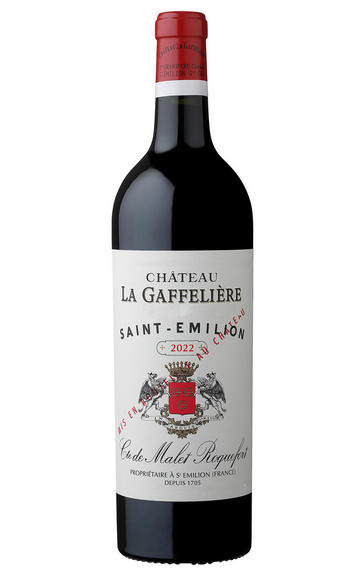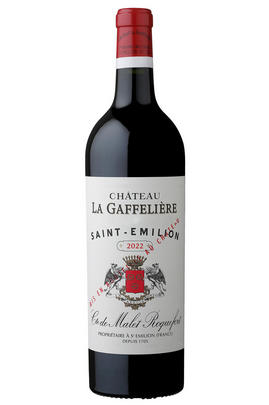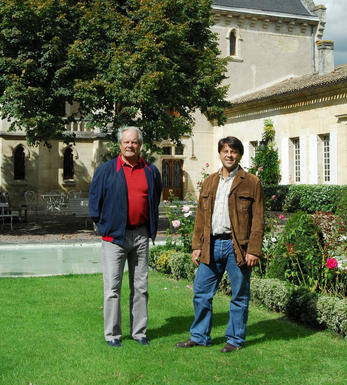
2022 Château La Gaffelière, St Emilion, Bordeaux

Critics reviews
The 2022 La Gaffelière continues this Saint-Émilion's strong run of form in recent years. The nose is extremely pure and shimmers with nascent excitement, beautifully defined with blackberry, raspberry and touches of cassis. If aromatics could "glide" then this would be a prime example. The palate is exquisite in terms of balance, just a little granular in texture. The 60% new oak is seamlessly integrated. There are hints of bay and tea leaf toward the silky-smooth finish, completing a potentially marvellous wine.
Drink 2030 - 2065
Neal Martin, Vinous.com (May 2023)
The 2022 La Gaffelière is a drop-dead gorgeous beauty. Refined, sculpted and wonderfully precise, La Gaffelière simply has it all. Hints of lavender, mint, blood orange, spice and black cherry fruit all race across the glass. Clean mineral notes and fine tannins support the finish. The delineation here is simply breathtaking. La Gaffelière is 60% Merlot and 40% Cabernet Franc. Élevage is expected to be 19 months in 50% new oak and 50% neutral barrels. The 2022 is another exceptional wine from the Malet Roquefort family.
Drink 2032 - 2062
Antonio Galloni, Vinous.com (May 2023)
The 2022 La Gaffeliere is composed of 86% Merlot and 14% Cabernet Franc. Deep garnet-purple in color, it slowly unfurls to reveal gorgeous notions of juicy blackberries, redcurrant jelly, and wild blueberries, followed by suggestions of rose oil, cardamom, and fragrant soil. The medium to full-bodied palate has bags of energetic black and red berry layers, supported by beautifully plush tannins and great tension, finishing long and perfumed. What a beauty!
Drink 2030 - 2065
Lisa Perrotti-Brown, The Wine Independent (May 2023)
Such a delicious wine in 2022, with mouthwateringly sappy tannins, juicy and approachable while being muscular and stacked, and here the concentrated blackcurrant and loganberry fruit is studded through with oyster shell salinity. La Gaffelière is not the most high-profile of the estates to have resigned from the St Emilion classification, but it's a real loss because finding these types of wines makes the ranking so worthwhile.
Look out also for a 100% Cabernet Franc cuvee (not tasted, so I'll be looking out, too) from this vintage to be released in a few years. Stéphane Derenoncourt consultant.
Drink 2028 - 2044
Jane Anson, JaneAnson.com (May 2023)
A blend of 60% Merlot and 40% Cabernet Franc, the 2022 La Gaffelière derives exclusively from the prime hillside vineyards below Ausone that made this estate so compelling in the early and mid-twentieth century, and the 2022 is the finest wine produced at this address in many a year, surpassing the 2019 and 2020 in quality.
Wafting from the glass with incipiently complex aromas of wild berries, violets, lilac, licorice, vine smoke and raw cocoa, it's medium to full-bodied, supple and seamless, with a deep, multidimensional and beautifully vibrant core of fruit and polished tannins, concluding with a long, mouthwatering finish.
William Kelley, Wine Advocate (April 2023)
This is serious. Bold and structured with beautiful fruit, which is crunchy and vibrant. Full body. Lots of complexity and depth with a wide and velvety tannin structure. Excellent length. Lots of blue fruits. Touch of whole cluster.
James Suckling, JamesSuckling.com (April 2023)
The 2022 Château La Gaffelière showed beautifully, with a medium to full-bodied, forward, sexy style carrying ample ripe black cherries, spring flowers, camphor, and graphite aromatics. These carry to a medium to full-bodied Saint-Emilion with nicely integrated tannins, remarkable purity, and a great, great finish.
This is clearly a gorgeous Saint-Emilion in the making and is well worth seeking out. The blend is 60% Merlot and 40% Cabernet Franc, and this is certainly in the same ballpark, if not better than, the 2018, 2019, and 2020.
Jeb Dunnuck, JebDunnuck.com (May 2023)
About this WINE

Chateau La Gaffeliere
Château La Gaffelière is owned by Léo de Malet Roquefort, and the 22 hectare property produces on average 10,000 cases per year. Located in the centre of the St. Emilion appellation, due south of St. Emilion town, the property shares a similar climate to that enjoyed by both St.Emilion and Pomerol: more continental than the maritime Médoc, with generally more spring rainfall, though less in summer and winter.
La Gaffeliere's vineyards (Cabernet Sauvignon 5%, Merlot 65%, Cabernet Franc 30%) lie on a sloped sandy/clay-limestone topsoil and limestone subsoil (a mix of Côtes and Pieds de Côtes). Fermentation takes place in stainless steel followed by extended wood maturation, with 33% of the barells being renewed annually.
La Gaffeliere is classified as a 1er grand cru classé(B).

St Émilion
St Émilion is one of Bordeaux's largest producing appellations, producing more wine than Listrac, Moulis, St Estèphe, Pauillac, St Julien and Margaux put together. St Emilion has been producing wine for longer than the Médoc but its lack of accessibility to Bordeaux's port and market-restricted exports to mainland Europe meant the region initially did not enjoy the commercial success that funded the great châteaux of the Left Bank.
St Émilion itself is the prettiest of Bordeaux's wine towns, perched on top of the steep limestone slopes upon which many of the region's finest vineyards are situated. However, more than half of the appellation's vineyards lie on the plain between the town and the Dordogne River on sandy, alluvial soils with a sprinkling of gravel.
Further diversity is added by a small, complex gravel bed to the north-east of the region on the border with Pomerol. Atypically for St Émilion, this allows Cabernet Franc and, to a lesser extent, Cabernet Sauvignon to prosper and defines the personality of the great wines such as Ch. Cheval Blanc.
In the early 1990s there was an explosion of experimentation and evolution, leading to the rise of the garagistes, producers of deeply-concentrated wines made in very small quantities and offered at high prices. The appellation is also surrounded by four satellite appellations, Montagne, Lussac, Puisseguin and St. Georges, which enjoy a family similarity but not the complexity of the best wines.
St Émilion was first officially classified in 1954, and is the most meritocratic classification system in Bordeaux, as it is regularly amended. The most recent revision of the classification was in 2012

Merlot
The most widely planted grape in Bordeaux and a grape that has been on a relentless expansion drive throughout the world in the last decade. Merlot is adaptable to most soils and is relatively simple to cultivate. It is a vigorous naturally high yielding grape that requires savage pruning - over-cropped Merlot-based wines are dilute and bland. It is also vital to pick at optimum ripeness as Merlot can quickly lose its varietal characteristics if harvested overripe.
In St.Emilion and Pomerol it withstands the moist clay rich soils far better than Cabernet grapes, and at it best produces opulently rich, plummy clarets with succulent fruitcake-like nuances. Le Pin, Pétrus and Clinet are examples of hedonistically rich Merlot wines at their very best. It also plays a key supporting role in filling out the middle palate of the Cabernet-dominated wines of the Médoc and Graves.
Merlot is now grown in virtually all wine growing countries and is particularly successful in California, Chile and Northern Italy.


Buying options
Add to wishlist
Description
This is an exceptional effort for the vintage. There are plenty of sumptuous, velvety and heady aromatics, but what sets the wine apart is its delicacy on the palate. It is part of the wine’s mystery that it can combine these two seemingly contradictory elements yet emerge so fully formed.
The finish is complete and very long indeed; here, the wine’s complexity comes to the fore, revealing silky plum, cool earth and iron ore notes. The progress made here in recent years is commendable and heartwarming. This is another superb wine in a run of very successful vintages.
Merlot 60%; Cabernet Franc 40%
Drink 2028 - 2050
Score: 18/20
Berry Bros. & Rudd (April 2023)
wine at a glance
Delivery and quality guarantee